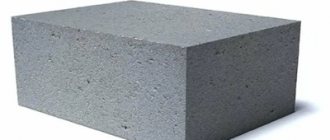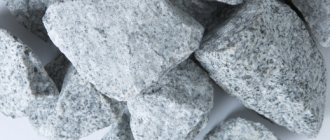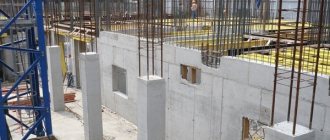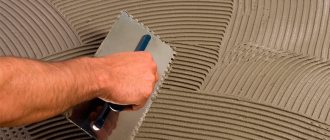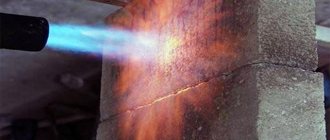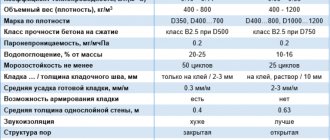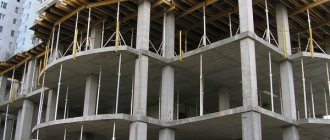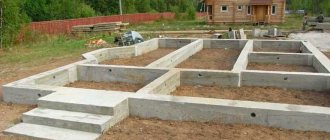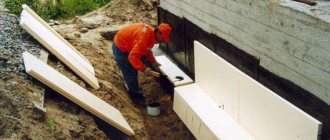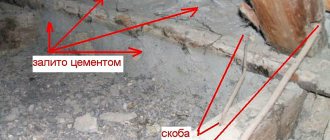Concrete is a popular building material obtained through the process of hardening a component mixture. The physical and mechanical properties of concrete depend on the formulation used, manufacturing technology and the stressed state of structures. Testing concrete before use allows you to determine its characteristics and avoid damage during further use.
Volume weight
Depending on the volumetric weight, concretes are distinguished
- heavy (2,200–2,400 kg/m3) and light (1,200–1,800 kg/m3).
- cellular concretes have a volumetric weight from 300 to 1,000 kg/m3.
Depending on the volumetric weight, concretes are heat-conducting (“cold”) or low-heat-conducting (“warm”). The higher the volumetric weight, the more thermally conductive the concrete is. i.e. “colder”.
Solutions are divided according to the type of filler. When using a heavy filler, such as sand, the solution turns out to be heavy, i.e. “cold”, and when using a light filler (boiler or metallurgical slag, light rocks - tripoli, pumice, tuff) - light, i.e. “warm” .
Abrasion
Abrasion is the loss of mass as a result of abrasive influences. It is installed according to the measurement methods described in GOST 13087-2018. There are three grades of concrete based on abrasion:
- G1: low abrasion. Suitable for use in heavy traffic conditions, such as highways or airfields.
- G2: medium abrasion. Used to create stairs or concrete floor slabs.
- G3: high abrasion. All other conditions.
Concrete grade
The grade of concrete or mortar means the magnitude of the destructive load in kilograms per 1 cm2 of the cross-sectional area of a standard sample (cube) tested for compression, made from a given concrete or mortar, and is expressed in kg/cm2.
To characterize concrete and mortars, compressive strength at the age of 28 days is taken. Building codes and regulations provide for the following brands:
- heavy concrete - 25, 35, 50, 75, 100, 150, 200. 300, 400, 500 and 600 kg/cm2
- lightweight concrete - 10, 15, 25, 35, 50, 75, 100, 150 and 200 kg/cm2
- solutions - 0, 2, 4, 10, 25, 50, 75, 100, 150 and 200 kg/cm2.
Mortar grade 0 was established to determine the strength of masonry on fresh, not yet hardened mortar and on freshly thawed mortar when producing masonry using the freezing method. Mortar grades 150 and 200 are used for hydraulic engineering and other special work.
Concrete and mortars do not resist tensile forces well. The compressive strength of concrete and mortars significantly (5-10 times) exceeds their tensile strength.
The strength of concrete and mortars is influenced by:
- a) activity of cement or other binder; %
- b) quality of aggregates;
- c) amount of water;
- d) conditions for preparing and curing concrete;
- d) age.
The higher the activity of the binder, the higher the strength of the concrete.
The purity of the aggregates and the absence of foreign impurities (clay, silt, etc.) are of great importance. When contaminated aggregates are used, the strength of concrete decreases.
In some cases, impurities cause changes in the volume of hardened concrete (for example, clays that swell with water) or the formation of compounds with cement that destroy concrete (for example, sulfuric acid compounds).
The irregular shape and rough surface of the aggregate provide better adhesion to the cement paste and therefore provide higher strength than with aggregates with a round shape and a rounded grain surface.
The quality of aggregates is also characterized by the grain size and the ratio between the quantities of particles of different sizes (grain composition).
A filler consisting of grains of the same size has the highest voids and the lowest density, and a filler consisting of grains of filler of different sizes has the highest density.
An increase in porosity (voidity) entails a decrease in the volumetric weight of the material and, conversely, a decrease in porosity leads to an increase in volumetric weight. For example, 1 m3 of sand with grains with a diameter of 1 mm weighs about 1400 kg, and with grains from 0.15 to 5 mm - 1600 - 1700 kg.
A solution of cement and sand with grains of different sizes has greater density and strength.
In addition, to produce such a solution, less binder is required, since its voids are lower.
The quality of concrete or mortar is also affected by the strength of the aggregate (in a piece). The strength of hard rock aggregates should exceed the required strength of concrete by at least 25-50%. If a material (crushed brick, slag, etc.) with low strength is used as a filler, then the strength of the concrete will depend to a large extent not only on the brand of cement, but on the strength of these fillers.
The amount of water in a concrete mixture or mortar is determined by the water-cement ratio (W/C), i.e., the ratio of the weight of water to the weight of cement. In this case, only free (not absorbed by aggregates) water is taken into account. It has been proven that with an increase in the water-cement ratio above a certain minimum limit, the strength of concrete decreases.
The explanation for this phenomenon is that cement combines with water, which makes up only 10-20% of its weight.
But if you prepare a concrete mixture with such a water-cement ratio (within 0.1-0.2). then such a mixture will be almost dry, it will be difficult! Mix well, and pack tightly into molds. Therefore, in practice, when preparing concrete mixtures and solutions, you have to take significantly more water. In rigid concrete mixtures W/C = 0.35-0.45, in plastic mixtures - 0.5-0.75.
The interaction of cement with water in concrete begins from the surface of the cement grains, and only gradually does water penetrate into them. Excess water evaporates over time, leaving air pockets and the cement stone in the concrete weakens. Therefore, the strength of concrete (or mortar) will be lower, the higher the porosity of the cement stone, i.e., the more water was taken to prepare the concrete mixture.
In lime and gypsum mortars, the ratio of the amount of water to the weight of lime or gypsum is determined by the water-lime and water-gypsum ratio, which play a role similar to the water-cement ratio.
Of particular importance for the strength of concrete are the thoroughness of mixing and the method of laying the concrete mixture.
Only with mechanized mixing can the required homogeneity of the concrete mixture be achieved. It should be laid using vibrators; this increases the strength of concrete by 20-30% compared to concrete laid manually.
The strength of concrete is also influenced by the curing conditions of freshly laid concrete. The most favorable conditions are humid aging conditions at temperatures from + 15 to + 20 °. Reducing the hardening temperature of concrete greatly slows down the process of increasing the strength of concrete and mortar. At a temperature of 0° and below, the hardening of concrete and mortar prepared with clean water (without added salts) stops and resumes only after thawing. In this case, some loss of strength occurs in the concrete.
It was noted above that the design strength of concrete and mortars is taken at the age of 28 days. However, the increase in the strength of concrete and mortars continues beyond this period, but at a slower pace. In some cases, it is necessary to impose requirements on the strength of concrete and mortars at an earlier age. The approximate increase in the strength of concrete based on Portland cement depending on age is shown in Table. 1.
| Age of concrete in days | Relative strength in % | Age of concrete in years | Relative strength in % |
| 7 | 60—75 | ||
| 28 | 100 | 1 | 175 |
| 90 | 125 | 2 | 200 |
| 180 | 150 | 4-5 | 225 |
The data in this table applies to concrete made with medium-active cement, hardening in a warm and humid environment. 28-day strength is taken as 100%.
Strength characteristics
Strength is considered the main characteristic of concrete (measured in kgf/m2). And we are talking, first of all, about tensile strength during bending. Strength depends on many factors, but the quality of materials used and proportions play a significant role. Strength is calculated using two methods:
- Destructive testing method, when they take a dried concrete cube, put it under a press and compress it until it breaks. The force spent on the destruction of a concrete sample is an indicator of strength.
- Non-destructive method. It is used after the fact, that is, when measuring the strength characteristics of a finished concrete structure. Strength is measured either with a Fizdel hammer, or a Kashkarov hammer, or a TsNIISK pistol. The technique of chipping the edge of a concrete structure is less commonly used.
If we consider concrete and its properties, then the first thing we pay attention to is strength, which is expressed in kgf/m2.
Density
The density of concrete refers to the degree to which the entire volume is filled with solids (hardened cement stone and aggregates).
Part of the volume of concrete usually consists of air-filled pores, formed, as noted above, due to the evaporation of water in the concrete mixture. A concrete density of 0.85 means that 85% of the volume is made up of the materials included in it, and. 15% - pores (emptiness). The density of concrete is one of its most important properties. The strength, water resistance, frost resistance, and therefore the durability of concrete depend on density.
To obtain concrete with high density it is necessary that:
- a) there was as little water as possible in the concrete mixture;
- b) the aggregates consisted of grains of different sizes;
- c) the volume of sand-cement mortar was 10-15% higher than the volume of voids in the coarse aggregate;
- d) good mechanized mixing and careful placement of the mixture were ensured.
Basic and secondary characteristics of concrete
The characteristics of concrete are conventionally divided into primary and secondary, but many believe that all indicators are equally important and necessary. Characteristics of concrete:
- Strength (especially tensile bending).
- Density.
- Shrinkage.
- Structure (porosity).
- Weight.
- Water resistance.
- Frost resistance and other characteristics (sound insulation properties, thermal conductivity, resistance to aggressive substances, fire resistance, etc.)
Let's consider each characteristic of concrete separately.
Waterproof
Water resistance is the property of concrete not to allow water to pass through.
The waterproof requirement applies to concrete used in the construction of reservoirs and hydraulic structures. The high-density concrete mixture meets the waterproof requirements. Absolute waterproofness is very difficult to achieve, since voids (pores) in concrete are connected into through channels through which water will leak. However, small-diameter pores create very high resistance to water movement, and the concrete turns out to be practically waterproof.
Water resistance, frost resistance and other characteristics of concrete
Water resistance or water resistance is also considered one of the important parameters, especially in the construction of hydraulic structures (concreting water channels, construction of dams, piers, lighthouses, tunnels, etc.) The level of water resistance is determined using a test similar to the method for determining strength. Two cubes of concrete are cut out, one of them is placed under a press, and the second is placed in water, allowing it to become saturated with moisture, after which it is also tested under pressure.
Frost resistance is the ability of concrete to withstand subzero temperatures or temperature changes for a long time without deformation or destruction. This parameter is partially influenced by porosity. There are other options, for example:
- thermal conductivity - the ability to transfer heat;
- soundproofing properties;
- resistance to acids and alkalis;
- fire resistance, etc.
Is it worth using concrete whose technical characteristics do not meet the values and standards specified in the design documentation? Of course not, so special additives are used to enhance the main and secondary characteristics.
Frost resistance
Frost resistance is the ability of a material not to collapse under the influence of alternating freezing and thawing.
The degree of frost resistance of concrete is measured by the number of tests of standard cube samples for repeated freezing and thawing. The test is carried out as follows: all materials that make up the concrete mixture are checked for compliance with state standards, then a concrete mixture of a given composition is prepared from these materials and six cube samples measuring 20X20X20 cm each are formed from it. After 26 days of normal storage, three cubes are saturated for two days at a temperature from +10 to + 20° with water and then subjected to alternate freezing (at a temperature of -15°) to thawing in water (at a temperature from +10 to +15° ) for 3 hours as many times as the number of cycles provided for by the technical requirements for this concrete.
After the last cycle, the cubes are kept in air for two days in a dry room and tested for compression. At the same time, the remaining three cubes that were not tested are tested for compression. In this case, the strength of concrete should not decrease by more than 25%, and the weight loss of the sample should not exceed 5%.
Such tests are mandatory when constructing concrete and reinforced concrete structures, the operation of which will take place under conditions of alternating moisture and freezing. Depending on the future application, concretes are tested for 10, 15, 25, 35, 50, 150 and 200 freezing cycles.
Deformability of concrete. Types of deformations
There are two main types of deformation in concrete:
- voluminous, developing in all directions under the influence of shrinkage, temperature and humidity changes
- a force that develops primarily in the direction of action of the forces. Some transverse deformations correspond to force longitudinal deformations; initial coefficient of transverse deformation of concrete v = 0.2 (Poisson's ratio).
Concrete is characterized by nonlinear deformation. Starting from low stresses, in addition to elastic deformations, inelastic residual or plastic deformations develop in it. Therefore, force deformations, depending on the nature of the application of the load and the duration of its action, are divided into three types: with a single load with a short-term load; long-term load; repeated load action.
Properties of concrete characterized by an increase in inelastic deformations over time under constant stresses are called concrete creep.
The property of concrete, characterized by a decrease in stress over time with a constant initial deformation, is called stress relaxation.
Creep and relaxation have a common nature and significantly affect the characteristics of reinforced concrete structures under load.
The nature of concrete creep is explained by its structure, the long process of crystallization and the decrease in the amount of gel during hardening of the cement stone. Under load, stress is redistributed from the structural component of the gel, which experiences viscous flow, to the crystalline intergrowth and filler grains. At the same time, the development of creep deformations is promoted by capillary phenomena associated with the movement of excess water in micropores and capillaries under load. Over time, the process of stress redistribution fades and deformation stops.
Creep is divided into linear, in which the relationship between stress and strain is approximately linear, and nonlinear, which begins with stresses exceeding the limit of formation of structural microcracks.
Shrinkage of concrete (mortar)
Hardening of concrete (mortar) is always accompanied by a change in its volume: when hardening in air, it dries out and shrinks, and when hardening in water, it swells slightly. Since the drying of concrete (mortar) outside occurs faster than inside, uneven shrinkage results, sometimes causing the appearance of small cracks. The more cement there is, the greater the shrinkage of concrete (mortar).
A significant reduction in concrete (mortar) shrinkage can be achieved by using rigid concrete with low W/C.
Structural evaluation of reinforced concrete
Zh. – basic and universal builds. material from which it is made approx. 85% of all build. designs. Such a widespread use of concrete is primarily due to the practically inexhaustible reserves of raw materials for binders and concrete fillers, as well as the ability to vary the composition of concrete to obtain a material with the required physical and mechanical properties. properties. The advantages of iron are: good dynamic resistance. and vibration loads; high durability; economical in operation; fire resistance (up to 500–600 °C); weather resistance; the ability to manufacture structures of any configuration; ability to block radioactive radiation. The disadvantages of housing include: large property. weight; high heat and sound conductivity; low crack resistance (with the exception of prestressed reinforced concrete) and, as a consequence, the possibility of corrosion of reinforcement.
Thermal conductivity
Thermal conductivity is the ability of a material to conduct heat.
The denser the material is in its structure, the more thermally conductive or “colder” it is; the more porous it is, the “warmer” it is. The thermal conductivity of a material also depends on the moisture content of the material. Water filling pores or voids in a material conducts heat, so a wet material is more thermally conductive.
Based on such considerations, ordinary beyun is not suitable for use as a wall material in residential construction. In construction technology, concretes with a porous structure are used for these purposes. They are characterized by lower thermal conductivity and therefore can be used as materials for wall enclosures. Such concretes include:
- a) concrete with light aggregates (metallurgical and boiler slag, expanded clay, pumice, etc.);
- b) large-porous (sandless) concrete produced from binder, water and coarse aggregate - light or ordinary;
- c) cellular concrete, which is characterized by the presence of closed air pores distributed throughout the entire mass of the material, which determines the low volumetric weight and high thermal insulation properties of cellular concrete products.
The most common main methods for producing cellular concrete are:
- a) the use of gas-forming substances (aerated concrete);
- b) the use of pre-whipped foam (foam concrete, foam silicate, foam gypsum, foam slag, etc.);
- c) introducing an excess amount of water into the mixture followed by its evaporation.
Abroad, the predominant method for producing cellular materials is based on gas-forming substances (aluminum powder). In Russia, a method based on mixing cement paste with pre-whipped foam is widely used.
Foam-based cellular concrete is obtained by hardening a mass prepared from a binder, filler, water and a foaming agent. To obtain such a mass, the mortar or dough must be of cast consistency; mixing must be done carefully.
Foam concrete mixers are used to prepare cellular concrete.
Various foaming agents are used - glue rosin, saponin and resin-saponin, aluminosulfonaphthene, HA, casein-rosin, liquid glass, etc.
The most common types of cellular materials include:
- foam concrete, obtained by mixing cement paste or mortar with separately prepared foam;
- foam silicate obtained by mixing lime-sand mortar with foam.
Similarly to what is indicated, when mixing a lime-sand solution with gas-forming substances, gas silicate can be obtained.
By analogy with concrete, solutions prepared with porous aggregate (slag, etc.) are classified as warm solutions.
Structure
According to clause 2.6 of GOST 25192-2012, concrete is divided according to its structure as follows:
- Dense. Almost the entire space of concrete is filled with substance.
- Porous. There is no fine aggregate. The space between the large porous aggregate is filled with a binder, which, as a result of the use of additives, also has a porous structure.
- Cellular. Artificially porous due to gas, foaming or aeration.
- Large porous. “Encapsulated” concrete is made without the use of sand and with a small amount of binder, which does not completely fill the voids between the grains of coarse aggregate.

